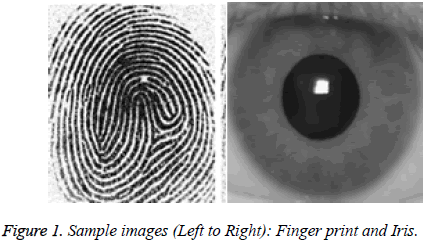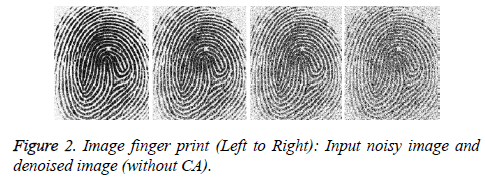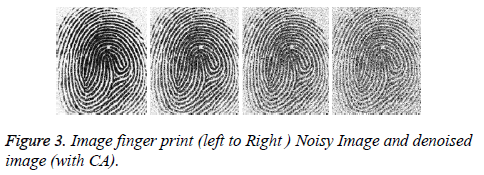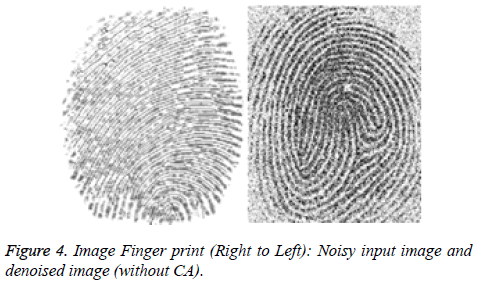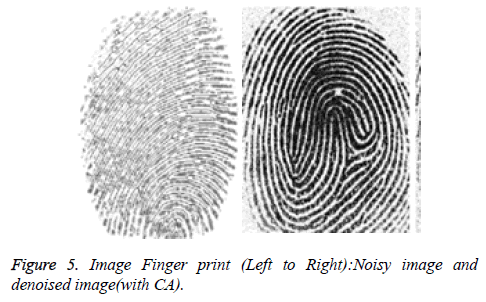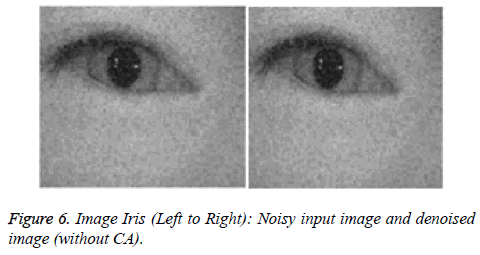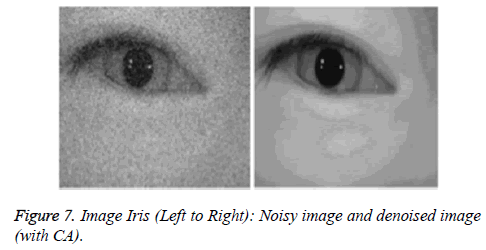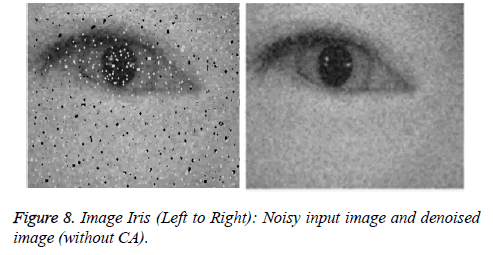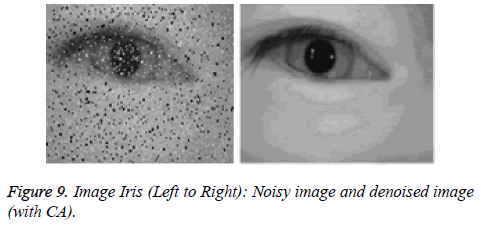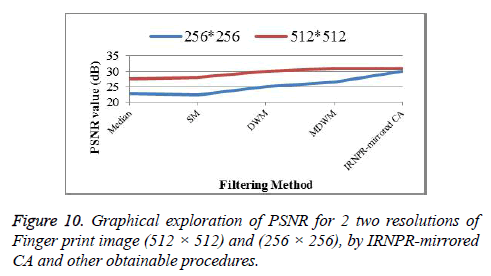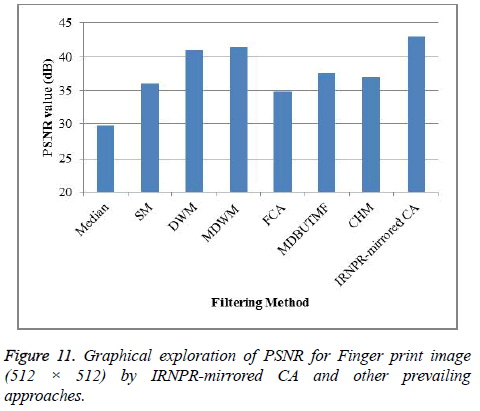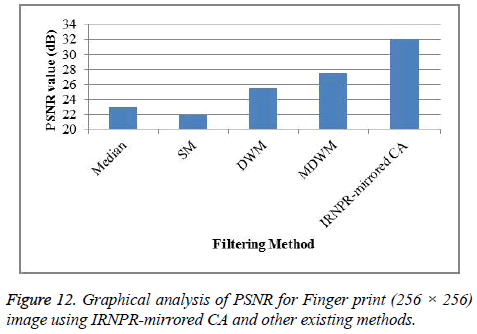Research Article - Biomedical Research (2018) Computational Life Sciences and Smarter Technological Advancement: Edition: II
An improved cellular automata (ca) based image denoising method for biometric applications
Suresh A1*, Malathi P2, Nagarani S3 and Oswalt Manoj S4
1Department of Information Technology, Sri Ramakrishna Institute of Technology, Coimbatore, India
2Sri Ranganathar Institute of Engineering and Technology, Coimbatore, India
3Department of Science and Humanities, Sri Ramakrishna Institute of Technology, Coimbatore, India
4Department of Computer Science and Engineering, Sri Ramakrishna Institute of Technology, Coimbatore, India
- *Corresponding Author:
- Suresh A
Department of Information Technology
Sri Ramakrishna Institute of Technology, India
Accepted date: February 01, 2017
DOI: 10.4066/biomedicalresearch.29-16-2321
Visit for more related articles at Biomedical ResearchAbstract
Biometric recognition plays a more important role in the industries and various plays to allow authenticated entry. The database would be created using the biometrics gathered from the users and authentication will be done by matching user biometric with the database. However this matching might increase the false positive rate in case of presence of salt and pepper noise in the images. This effort antagonizes a completely unique approach for screaming pel recognition and refurbishment of grey scale image victimization mirrored cellular automata (CA). The planned method eliminates salt and pepper noise from a tainted image. The planned technique permits extension lead of window size vigorously throughout great noise concentrations. The planned technique uses reflected CA supported Moore neighborhood (8-neighborhood cell). This image denoising method is examined with numerous prevailing image denoising methods like, Median filter, Switch Median (SM) filter, Directional- Weighted-Median (DWM) filter, changed DWM (MDWM), Fuzzy Cellular Automata (FCA), changed call primarily based asymmetrical cut Median Filter (MDBUTMF), and Contra mean value (CHM) filter. 3 sample pictures (Finger print, Iris, and Mandrill) of 2 completely diverse determinations (512 × 512) and (256 × 256) are engaged for the recital examination. The reflected CA is evaluated in contradiction of Peak signal-to-noise (PSNR), Mean square Error (MSE), and Structural SIMilarity (SSIM). It’s ascertained that reflected CA performs higher than the opposite prevailing practices by means of PSNR.
Keywords
Cellular automata (CA), Mirrored CA, Mean squared error (MSE), Peak signal-to-noise ratio (PSNR), and Structural SI milarity (SSIM)
Introduction
The furthermost prevalent approaches of protecting data and resources protected are to practice password and User ID/PIN security. These systems necessitate the user to validate them by inward bound a "secret" password that they had beforehand fashioned or were allocated. These schemes are disposed to equitation from either a brute force effort to blow the password or from passwords which were not sole or even which were dispatched adjacent the computer itself. A Biometric Identification scheme is one in which the user's "body" turn out to be the password/PIN. Biometric features about the distinct are what make that person sole and consequently can be castoff to validate a user's admittance to numerous schemes.
Biometrics bids sole assistances for recognizing human beings. Tokens, Photo ID cards can be misplaced, pinched, replicated or left at home, Passwords can be elapsed communal or perceived but Biometrics grips the potential of firm, easy-touse, perfect, consistent, and less costly authentication for an assortment of applications. The biometric identification methods substitute the token recognition scheme where a person is proved by means of his license or pass codes and favored over outdated passwords and PIN-based approaches. Certain recognized Biometric identification methods are stated underneath, “Fingerprint recognition, Voice/sound recognition, Palm vein recognition, Iris recognition, Retina scan recognition and so on”.
Denoising is a crucial issue in image process. Impulse noises area unit evoked as a result of bad pixels in camera sensors or broadcast during a clattering channel. Two common forms of impulse noise area unit the random valued noise and the saltand- pepper noise. For the photographs tainted by salt-andpepper noise, clattering pixels take solely the utmost and the least standards within the dynamic vary. These noises will scale back the standard of pictures and harm the appearance of facts for pictures effectively. Image filtering will effectively scale back the noise within the image. The objective of impulse noise elimination is to subdue the noise to realm the truthfulness of edge and aspect info. There are a unit several efforts on the refurbishment of pictures tainted by impulse noise. An upright and well-organized noise removal method ought to take away most noise further because it ought to retain the necessary feature the maximum amount as potential. The same old strategies of image filtering normally are spatial filtering and frequency domain filtering. There are numerous filtering strategies accessible to de-noise the image. Earlier techniques notice the neighboring extreme “noisy” pel to be filtered out. Alas, the intense pixels that area unit considered noise may additionally contain the first details that may further be removed throughout the smoothing method.
An economical denoising technique is projected victimization reflected CA supported Moore neighborhood (8- neighborhood cell), Iterative Refined clattery picture element Restoration (IRNPR) with mirrored CA. This image denoising method is examined with numerous prevailing image denoising methods like, Median filter, Switch Median (SM) filter, Directional Weighted Median (DWM) filter, changed DWM (MDWM), Fuzzy Cellular Automata (FCA), changed call based mostly Unsymmetric cut Median Filter (MDBUTMF), and Contra mean (CHM) filter. 3 sample pictures (Finger print, Iris, and Mandrill) of 2 completely different resolutions (512 × 512) and (256 × 256) area unit taken for the performance analysis. IRNPR-mirrored CA is examined in contradiction of Peak Signal-to-Noise Ratio (PSNR), Mean square Error (MSE), and Structural SIMilarity (SSIM). It’s determined that projected method performs higher than the opposite existing technique in terms of PSNR. The remainder of this effort is prearranged as lower than: Works that square measure associated with the denoising of pictures square measure given in Section II The operating and outline of the planned method for the noise constituent recognition and reinstating of gray scale pictures square measure given in an elaborate way in section III. Potency and recital of the planned method square measure examined over investigating within the section IV. Finally, section V concludes with a thought to reinforce the denoising technique within the future [1,2].
Related Work
Protter and Elad [3] have used redundant and distributed depictions for eliminating noise from the image. Associate in nursing algorithmic rule named K-SVD was accustomed train a sparsified lexicon for the pictures that were corrupted. Here, the students generalized the higher than mentioned algorithmic rule through the subsequent ways in which (i) range of repetitions were abridged for broadcasting the lexicon from one border to a different or subsequent frame and (ii) covers were be close to in each temporal and spatial adjoining positions. These mentioned ways in which were accustomed have a substantial profit in complexness and denoising performance. A distinctive method termed support vector regression (SVR) was functional by the investigators of [4] so as to acquire purged of noise from a picture. The support vector standards and their weights were calculated when the vociferous pictures were qualified with a ground-truth. These calculated values were accustomed take away the haphazard noise gift in a picture at varied stages on a pixel-by-pixel root. This can be Associate in nursing example-based approach as a result of its cast-off SVs for noise elimination. The investigational outcome study bestowed during this object exhibited that the SVR primarily based denoising methodology performs higher than the Besov ball forecast method on the image that was non-natural by means of each PSNR and visual examination.
Researchers of the work [5] have cast-off PCA in conjunction with native constituent combination (LPG) for noise elimination. With the intention to realm the native configurations, a vector variable was sculptural from a constituent and their adjacent neighbor. Their examples for coaching were non-appointive from the native window over block matching primarily based LPG. This methodology ensures that solely alike at ease and example blocks were castoff for the approximation of PCA alteration. For higher performance, LPG-PCA methodology was iterated. Investigational outcome specified within the paper uttered that the LPG-PCA methodology outperforms the progressive noise elimination procedures. Another technique was projected in [6] for removal of random noise. This methodology used Nonlocal suggests that formula for economical noise elimination and also the outcomes of the trial exhibited that NL-means primarily based formula accomplished than the progressive denoising formula. Changhong et al. [7] proposes a completely unique enhanced median filter formula for the photographs extremely tainted with salt-and-pepper noise. Primarily, altogether the pixels square measure classified supported the native datum data into signal pixels and crying pixels by mistreatment the Max-Min noise detector.
The crying pixels square measure distinguished into 3 categories like small, modest, and great-density noises. Finally the biased 8-neighborhood resemblance perform filter, the five × five median filter and also the 4-neighborhood mean filter square measure adopted to get rid of the noises. The papers [8] define the assiduousness of cellular automata (CA) for many image process tasks like denoising and have detection. The accrued range of cell states (i.e. constituent intensities) results in an enormous increment within the range of potential rules. Consequently, an abridged intensity illustration was used, resulting in a 3 state cellular mechanisms that was additional sensible. In concurrence, a changed ordered floating forward search technique was developed so as to hurry up the selection of fine rule sets within the CA coaching stage. In paper [9] a replacement methodology was projected to eradicate noise and to determine image edges through then perform of fuzzy cellular automata as in [10]. During this methodology, eight specific contiguous circumstances square measure considered for every component and sixteen numbers area unit resulting from these transitions. Such numbers area unit cast-off as effort for the fuzzy membership performs. The fuzzy rule ground was made in such the simplest way on properly acknowledge the transition of every component.
A changed call based mostly Unsymmetrical cut Median Filter (MDBUTMF) joined with Fuzzy Noise Reduction methodology (FNRM) was planned [11] for the refurbishment of color pictures that are tremendously tainted by salt and pepper noise. This filter alternates the howling picture element by cut norm once the weather with 0’s and 255’s values are gift. The partial noise detached pictures are additional treated by FNRM to get a completely noise unconcerned image associate amended form of the directional weighted median (DWM) filter was planned in paper [12]. This methodology will considerably progress the recital of the directionalweighted- median filter because it includes further ways (12 directions) for edge detection, while the DWM filter solely pays four directions. These further guidelines amend the precision of edge recognition.
Esakkirajan et al. [13] detached the greater thickness salt and pepper noise in grey scale and color pictures employing a changed call based mostly asymmetric cut median filter. This algorithmic rule exchanges the howling picture element with the cut norm, once all the picture element values within the designated window are 0’s and 255’s. The noise picture element was substituted by the average of all the weather within the nominative window. Gorsevski et al. [14] perceived grain boundaries in misshapen stuns by cellular automata refrain. Two-dimensional CA was functional to the removal of skinny segments from misshapen rocks and grain boundary recognition. The haul out boundaries comprises options like alignment, shape, and spatial dissemination, shaped from a CA Moore’s environment-grounded instructions practice. The Moore’s atmosphere entails of a three × three matrix of varied the appearance by distinguishing amongst a middle picture element and its neighbors. These rules calculable the longer term state of every cell whereas the amount of recurrences to fake boundary recognition was user-specified. The yield at every spherical provides numerous recognition circumstances of grain boundaries. Kumar and Sahoo [15] planned a unique practice for edge recognition exploiting CA.
Chhabria and Shende [16] intended a CA image removal algorithmic rule for head and hand gestures acknowledgment. These real time vision systems are often applied in associate multimedia atmosphere. It entails of image capture, image removal, pattern connotation, and command approximation. The gestures are joined to the pre-stored information of gestures. Then, the hardware association was achieved as per the joined signs on quad-directions. This movement also can be controlled mistreatment voice commands. The cellular automata accommodate a multi-dimensional array/grid of cells. These cells will inhabit several finite varieties of attainable states. The presence of the cells are at the same time updated in line with a state transition performs. Aydogan [17] developed a Cellular Neural Network (CNN) grounded mostly edge recognition of second information. This CNN replica was castoff for the recognition of the image body and edges. A random image process algorithmic rule was planned supported the instantaneous vicinity link of the cells. This methodology was cast-off for edge recognition and image enhancement. CNN was functional to arena and artificial information made for edge recognition of skinny surface earth science entities that defend one another in numerous depths and dimensions. A biological process edge detector was projected victimization varied instruction CA by Sato and Kanoh [18]. The training formula cast-off here was organic phenomenon programming, wherever the transition instruction was determined because the manifestation by the body coaching CA was produced by smart edge detector and 2 impartial tasks were intended. The target jobs were enhanced by a multi-objective biological process formula.
Qadir et al. [19] projected a completely unique image noise filtering formula supported CA. This technique may also take away the impulsive noise from the rip-roaring pictures. Nonuniform CA rules were designed to get rid of the noise from general and medical pictures. Hsu, et al. [20] developed a formula for salt and pepper noise reduction method victimization CA. The software system programming model referred to as CAID (Cellular Automata Image Denoising) toolkit was established victimization MATLAB. The properties concerning instinct or salt and pepper noise were stated by Selvapeter and Hordijk [21]. In impulse noise, solely a haphazard part of image pixels are corrupted. These rip-roaring pixels whichever take terribly massive price (gray {scale price| value} 255) as an optimistic impulse or terribly little value zero as undesirable impulse. Fastened price boundary conditions ar applied within the cellular automata filter in salt and pepper noise elimination, i.e., update instruction is functional solely to the non-boundary cells. The bulk CA update instruction wont to take away impulse noise was mentioned within the paper. The noise propagation stemmed from the settled CA rule is resolved by employing a haphazard instruction for breaking mainstream ties. A CA replica for eliminating salt and pepper noise and uniform noise was projected by Dalhoum et al. [22]. The projected CA model at the start checks the kind of noise by calculating the bar graph of the rip-roaring image. The CA transition instruction that is employed to get rid of the salt and pepper noise was mentioned within the paper. The methods for coaching CAs to implement justly common place image process responsibilities to a great level of recital for projected by Rosin [23]. In CA, the fastened price boundary circumstances are functional during which transition states are enforced solely to non-boundary cells. The instruction set is verified at every pel to confirm if any of its instructions approves the pel neighborhood pattern. The paper designates that the method of applying the principles are continued till the amount of iterations has reached a planned most.
Image Denoising Using Mirrored CA
This segment defines the image denoising method exploitation IRNPR-mirrored CA for the biometric recognition system. First, the summary of the noise filtering methodology is instructed with the design. Then, the IRNPR-mirrored CA for increased image denoising is mentioned.
CA and its characteristics
Based on the adjoining cell’s states, the CA replica transition instruction decides the neighborhood association amongst the automata. The formal automaton at time (t) be influenced by on the state of adjacent cells at time (t-1). There are a unit four categories to classify all potential behavior in CA. In class 3, the majority initial configurations relax once a transient amount to apparently unpredictable area time behavior. The uniform cellular automata area unit category three.
Application of CA in image process
Uniform cellular automata instructions area unit engineered to get rid of impulse blare from binary and grey scale pictures. A haphazard CA instruction is employed to reduce noise propagation gift in settled CA filters. A Moore neighborhood (the eight adjoining cells encompassing a cell) is taken into account. A 2-D CA with an easy modernize rule is functional as effective impulse noise filter in digital pictures. CA implements mounted price boundary conditions wherever the fill in rule is functional solely to non-boundary cells. The preliminary CA lattice outline is that the image tainted by Associate in Nursing impulse image. The mainstream CA modernize rule tells that if the middle constituent grey level is zero or 255, then the bulk grey level within the native neighborhood is employed to interchange the middle pixel’s price. The settled or random CA philosophy is employed once there's no majority grey level within the native neighborhood. Within the random philosophy, the grey price of indiscriminately chosen constituent within the neighborhood replaces the middle constituent. Within the settled philosophy, the mounted grey level within the neighborhood replaces the middle constituent. The noise broadcast occasioned from the settled CA rule is resolved by haphazard rule. A random CA performs higher than the settled CA for grey level pictures. CA transition rule is employed within the elimination of salt and pepper noise. This rule drafts if the present constituent is corrupted. Just in case of prevalence of noise, if all adjacent area unit clamorous, the present constituent is substituted by the typical of neighbors. If all neighbors aren't clamorous, then their median replaces the present automation state. The mounted boundary downside is solved by reflected CA.
Design of noise filtering
Primarily, a check image is administered to notice the occurrence of impulse noise. Any constituent image is chosen and patterned either or not it's noise free or clamorous. This can be done by checking whether chosen constituent price is most or least (0 or 255). If the worth is either zero or 255 then the constituent is clamorous and managed by repetitious purification technique. Else the values is not zero or 255, the constituent is noise open and remains unaffected.
Where In the salt and pepper noise, the tainted constituent takes one in all the 2 totally different values: black or white. The median sieve is employed to get rid of unsolicited noise and upsurge image excellence. CA entails of interconnected cells, every of that has Associate in nursing automaton. Associate in Nursing automaton that may be a mechanical device wont to execute easy calculations encompasses a state ever-changing.
Added, a three × three window focused at (i, j) is functional to the clamorous constituent. to interchange this clamorous constituent, the neighbor constituents of this pixel area unit thought-about exploitation IRNPR-mirrored CA, and so checked whether or not all the neighboring pixels area unit clamorous or not. Paste your text here and click on “Next” to look at this text redactor do its issue. Don’t have any text to check? Don’t have any text t check? Click “Select Samples”.

Where Xi,j = Intensity value of pixel at location (i,j)

Further, a three × three window targeted at (i, j) is applied to the clanging picture element. to exchange this clanging picture element, the neighbor picture elements of that pixel at thoughtabout exploitation IRNPR-mirrored CA, and so checked whether or not all the adjoining pixels are clanging or not. CA with buffering scheme is employed within the planned methodology. i.e., whereas hard the worth of elite picture element at time t, the worth of adjoining pixels at time (t-1) hold on within the buffer is employed. CA may be outlined as (I, N, V, F). I could be a cellular house fashioned by a 2 dimensional array of maximum cells, I = {(a,b),1 ≤ a ≤ m, 1 ≤ b ≤ n}, N – form of adjacency (Moore neighborhood), V – Set of adjacency picture element price, F- Transition Perform. If all adjacent pixels are clanging i.e. they need values either zero or 255 as shown in (3), then they're thought-about as clanging picture element and also the window is extended to 5 × 5.

If a minimum of a number of the pixels don't seem to be rackety, then the median of the neighbor pixels are calculated by excluding the rackety pixels (0 or 255). The chosen picture element is substituted with this median. Then the method is touched to next picture element. Deliberate a 3 × 3 window as shown in fig two. Here X(i, j) is that the chosen picture element and alternative pixels are subsequent of X(i, j).

Where p=comprises 8 neighbor pixels of X(i,j), If the noise perseveres in 5x5 window additionally, the window is prolonged to 7 × 7. If the pixels aren't blatant notice the norm of residual pixels of 5 × 5 window and reinstate the worth to X(i, j) as in equation five. If all the adjacent pixels ar blatant in 7 × 7 window, the norm of adjacency is considered else if a number of the adjacent pixels aren't blatant in 7 × 7 window, then the norm of remaining pixels without blatant pixels is premeditated. Then the chosen picture element is substituted with the intended worth.



Finally, once using these procedures for each pel within the image, the reinstated image is attained. The standard of the image is examined victimization Mean Square Error (MSE). If the MSE of the de-noised image is below the MSE of preceding generation cellular automata, the image is noise permitted. Or else the image entails of noise. Once an occasional MSE reinstated image is attained, that procedures the ultimate de-noised noise- open image.
Performance Analysis
The planned image denoising methodology is analyzed for four totally {different|completely different} grey scale pictures of 2 different resolutions every. The pictures square measure finger print (512 × 512), (256 × 256), Iris (512 × 512), (256 × 256) model of unique Finger print and Iris pictures square measure specified in Figure 1.
Outcomes for 10% salt and pepper noise
The output results of denoised image sample to fingerprint is shown in Figure 2 (without CA)
The output results of denoised image sample to fingerprint is shown in Figure 3 (with CA) , Table 1 shows the performance comparison results of the denosiy images related to fingerprint with three different parameters (MSE,PSNR and SSIM).
| Methods | MSE | PSNR | SSIM |
|---|---|---|---|
| Noisy Image | 1.8605e+03 | 15.4344 | 0.4019 |
| Without CA | 27.2664 | 33.7745 | 0.9784 |
| With CA | 3.1119 | 43.2006 | 0.9977 |
Table 1. MSE, PSNR and SSIM values for 10% salt and Pepper noise in Finger print image.
Results for 90% salt and pepper noise
The output results of denoised image sample (salt 90% and pepper noise) to fingerprint as shown in Figure 4 (without CA). The output results of denoised image sample (salt 90% and pepper noise) to fingerprint is shown in Figure 5 (with CA).
Table 2 shows the performance comparison results of the denosiy images related to fingerprint with three different parameters (MSE, PSNR and SSIM).
| Methods | MSE | PSNR | SSIM |
|---|---|---|---|
| Noisy image | 1.6701e+04 | 5.9034 | 0.0273 |
| Without CA | 1.4083e+04 | 6.6437 | 0.0247 |
| With CA | 172.8126 | 25.7550 | 0.8682 |
Table 2. MSE, PSNR and SSIM values for 90% salt and Pepper noise in Finger print image.
Iris image – 10% noise
The output results of denoised image sample (salt 10%) to iris are shown in Figure 6 (without CA). The output results of denoised image sample (salt 10%) to iris are shown in Figure 7 (with CA).
Table 3 shows the performance comparison results of the denosiy images related to iris (10% noises) with three different parameters (MSE, PSNR and SSIM).
| Methods | MSE | PSNR | SSIM |
|---|---|---|---|
| Noisy Image | 1.8589e+03 | 15.4382 | 0.4576 |
| Without CA | 69.4081 | 29.7167 | 0.9581 |
| With CA | 8.0039 | 39.0978 | 0.9952 |
Table 3. MSE, PSNR and SSIM values for 10% noise in iris image.
Iris–90% noise
The output results of denoised image sample (salt 90%) to iris are as shown in Figure 8 (without CA). The output results of denoised image sample (salt 90%) to iris are shown in Figure 9 (with CA).
Table 4 shows the performance comparison results of the denosiy images related to iris (90% noises) with three different parameters (MSE, PSNR and SSIM).
| Methods | MSE | PSNR | SSIM |
|---|---|---|---|
| Noisy Image | 1.66E+04 | 5.9329 | 0.0317 |
| Without CA | 1.40E+04 | 6.6607 | 0.0284 |
| With CA | 304.2348 | 23.2987 | 0.7909 |
Table 4. MSE, PSNR and SSIM Values for 90%noise in iris image.
Contrast with prevailing ways
The images are examined by means of Peak Signal-to-Noise Ratio (PSNR) [24], Mean Squared Error (MSE) [25], and Structural SIMilarity (SSIM) [26].



Two non-negative image signals a and b are associated with one another for the dimension of SSIM [26]. The subsequent symbolizations are cast-off in equation 10 Table 5.
| Density | 3 × 3 | 3 × 3 or 5 × 5 | Refined 3 × 3 or 5 × 5 | Iterative refined 3 × 3 or 5 × 5 or 7 × 7 |
|---|---|---|---|---|
| 10 | 42.97 | 42.91 | 42.9944 | 43.0698 |
| 20 | 39.20 | 39.14 | 39.1135 | 39.2165 |
| 30 | 36.64 | 36.61 | 36.7338 | 36.6313 |
| 40 | 33.87 | 34.56 | 34.9466 | 34.8904 |
| 50 | 29.98 | 32.63 | 33.3527 | 33.1090 |
| 60 | 24.49 | 29.14 | 31.6570 | 31.8089 |
| 70 | 19.36 | 23.33 | 29.9900 | 30.1723 |
| 80 | 14.26 | 16.66 | 26.0760 | 28.4337 |
| 90 | 9.76 | 10.72 | 16.8664 | 25.9115 |
Table 5. PSNR (dB) for Finger print (512 × 512) image for diverse window sizes, numerous noise densities and IRNPR-mirrored CA.
PSNR is examined for Finger print (512 × 512) image for diverse window sizes, several noise densities and IRNPRmirrored CA. The comparative studies are specified in Table 6.
| Density | SM | DWM | MDWM | FCA | CHM | IRNPR- mirrored CA |
|---|---|---|---|---|---|---|
| 10 | 36.12 | 40.78 | 41.45 | 35 | 37.31 | 43.06 |
| 20 | 33.42 | 37.02 | 38.22 | 33.50 | 34.59 | 39.21 |
| 30 | 31.36 | 34.63 | 35.97 | 32.70 | 32.99 | 36.63 |
| 40 | 29.88 | 32.51 | 34.07 | 31.20 | 33.01 | 34.89 |
| 50 | 28.54 | 30.23 | 32.69 | 29.20 | 29.53 | 33.10 |
| 60 | 26.76 | 27.69 | 31.21 | 27.80 | 27.20 | 31.80 |
| 70 | 24.47 | 25.23 | 29.72 | 26.50 | 26.45 | 30.17 |
| 80 | 19.52 | 21 | 27.94 | 23.70 | 22.56 | 28.43 |
| 90 | 8.80 | 15.45 | 25.50 | 18.37 | 19.57 | 25.91 |
Table 6. PSNR for Finger print image (512 × 512) by means of IRNPR-mirrored CA and other Prevailing techniques.
The subsequent notations are cast-off in equation 10:
• μa is the average of a.
• μb is the average of b.
• σa2 is the variance of a.
• σb2 is the variance of b.
• σab is the covariance of ab.
• C1 and C2 are two constants to evade uncertainty
• [26].
The prevailing image denoising techniques taken for the examination are Median filter, Switch Median (SM) filter [1], Directional-Weighted-Median (DWM) filter [12], Modified DWM (MDWM) [4], Fuzzy Cellular Automata (FCA) [10], Modified Decision Based Unsymmetric Trimmed Median Filter (MDBUTMF) [19], and Contra Harmonic Mean (CHM) filter [10]. PSNR is evaluated for two resolutions of the Finger print image (512 × 512), and (256 × 256), with IRNPRmirrored CA and other prevailing approaches. The comparative exploration is specified in Figure 10. PSNR is evaluated for Finger print image (256 × 256) with IRNPR-mirrored CA and other prevailing approaches. The comparative studies are specified in Figures 10 and 11. PSNR, MSE, and SSIM are examined for Finger print (512 × 512) image for diverse noise densities by means of IRNPR-mirrored CA (Figure 12). The relative examination is specified in Table 7.
| Noise Density | PSNR(dB) | MSE | SSIM |
|---|---|---|---|
| 10 | 43.06 | 3.3 | 0.99 |
| 20 | 39.21 | 7.78 | 0.99 |
| 30 | 36.63 | 14.12 | 0.99 |
| 40 | 34.89 | 21.08 | 0.98 |
| 50 | 33.1 | 31.78 | 0.97 |
| 60 | 31.8 | 42.87 | 0.96 |
| 70 | 30.17 | 62.49 | 0.95 |
| 80 | 28.43 | 93.26 | 0.92 |
| 90 | 25.91 | 166.69 | 0.86 |
Table 7. PSNR, MSE, SSIM for Finger print (512 × 512) image for diverse noise densities by means of IRNPR-mirrored CA.
Conclusion and Future Work
An economical denoising technique is projected exploitation reflected CA supported Moore neighborhood (8-neighborhood cell). This image denoising technique is analyzed with many existing image denoising techniques like, Median filter, Switch Median (SM) filter, Directional-Weighted-Median (DWM) filter, changed DWM (MDWM), Fuzzy Cellular Automata (FCA), changed call primarily based asymmetrical cut Median Filter (MDBUTMF), and Contra mean (CHM) filter. 3 sample pictures (Finger print, Iris, and Mandrill) of 2 totally different resolutions (512 x 512) and (256 x 256) are taken for the recital examination. The reflected CA is analyzed against Peak ratio (PSNR), Mean square Error (MSE), and Structural SIMilarity (SSIM). It’s ascertained that reflected CA performs higher than the opposite existing methodologies in terms of PSNR. This reflected CA primarily grounded image denoising method is distended to greater resolution image process with quicker computing methods such as parallel computing.
References
- Toh KKV, Isa NAM. Noise Adaptive Fuzzy Switching Median Filter for Salt-and-Pepper Noise Reduction. Signal Process Lett IEEE 2010; 17: 281-284.
- Dharmarajan R, Kannan K. A hypergraph-based algorithm for image restoration from salt and pepper noise. AEU Int J Electron Commun 2010; 64: 1114-1122.
- Protter M, Elad M. Image Sequence Denoising via Sparse and Redundant Representations. IEEE Transact Image Process 2009; 18: 27-35.
- Li D. Support vector regression based image denoising. Image Vision Comput 2009; 27: 623-627.
- Zhang L, Dong W, Zhang D, Shi G. Two-stage image denoising by principal component analysis with local pixel grouping. Pattern Recogn 2010; 43: 1531-1549.
- Lu K, He N, Li L. Nonlocal Means-Based Denoising for Medical Images. Comput Math Methods Med 2012; 2012: 1-8.
- Changhong W, Taoyi C, Zhenshen Q. A novel improved median filter for salt-and-pepper noise from highly corrupted images. Syst Control Aeronaut Astronaut (ISSCAA) 2010.
- Rosin PL. Image processing using 3-state cellular automata. Computer Vision Image Understanding 2010; 114: 790-802.
- Mirzaei K, Motameni H, Enayatifar R. New method for edge detection and de noising via fuzzy cellular automata. Int J Phy Sci 2011; 6: 3175-3180.
- Sadeghi S, Rezvanian A, Kamrani E. An efficient method for impulse noise reduction from images using fuzzy cellular automata. Ommunications 2012; 66: 772-779.
- Vimala T. Salt and pepper noise reduction using mdb utm filter with fuzzy based refinement. Int J Management IT Eng 2012; 2: 447-461.
- Lu CT, Chou TC. Denoising of salt-and-pepper noise corrupted image using modified directional-weighted-median filter. Pattern Recogn Lett 2012; 33: 1287-1295.
- Esakkirajan S, Veerakumar T, Subramanyam AN, PremChand CH. Removal of High Density Salt and Pepper Noise Through Modified Decision Based Unsymmetric Trimmed Median Filter. IEEE Signal Process Lett 2011; 18: 287-290.
- Gorsevski PV, Onasch CM, Farver JR, Ye X. Detecting grain boundaries in deformed rocks using a cellular automata approach. Computers Geosci 2012; 42: 136-142.
- Kumar T, Sahoo G. A Novel method of edge detection using cellular automata. Int J Comput Appl 2010; 9: 38-44.
- Chhabria SA, Shende RS. Cellular Automata Image Extraction Algorithm for Gestures Recognition. Int J Comput Sci Technol 2011; 2: 251-255.
- Aydogan D. CNNEDGEPOT: CNN based edge detection of 2D near surface potential field data. Comput Geosci 2012; 46: 1-8.
- Sato S, Kanoh H. Evolutionary design of edge detector using rule-changing Cellular automata. Nature Biol Inspired Comput (NaBIC) 2010.
- Qadir F, Peer MA, Khan KA. An effective image noise filtering algorithm using cellular automata. Comput Commun Informatics (ICCCI) 2012.
- Hsu CY, Tsui TS, Yu SS, Tseng KK. Salt and Pepper Noise Reduction by Cellular Automata. Int J Appl Sci Eng 2011; 9: 2-19.
- Selvapeter PJ, Hordijk W. Cellular automata for image noise filtering. Nature Biol Inspired Comput 2009; 2009: 193-197.
- Sakthivel K, Jayanthiladevi A, Kavitha C. Automatic detection of lung cancer nodules by employing intelligent fuzzy cmeans and support vector machine. Biomed Res 2016; 27: S123-S127.
- Rosin PL. Training Cellular Automata for Image Processing. IEEE Transact Image Process 2006; 15: 1-12.
- Esakkirajan S, Veerakumar T, Subramanyam AN, PremChand CH. Removal of High Density Salt and Pepper Noise Through Modified Decision Based Unsymmetric Trimmed Median Filter. Signal Process Lett IEEE 2011; 18: 287-290.
- Zhou W, Bovik AC, Sheikh HR, Simoncelli EP. Image quality assessment: from error visibility to structural similarity. Image Process 2004; 13: 600-612.
- Hsieh MH, Cheng FC, Shie MC, Ruan SJ. Fast and efficient median filter for removing 1–99% levels of salt-and-pepper noise in images. Eng Appl Artificial Intell 2013; 26: 1333-1338.
